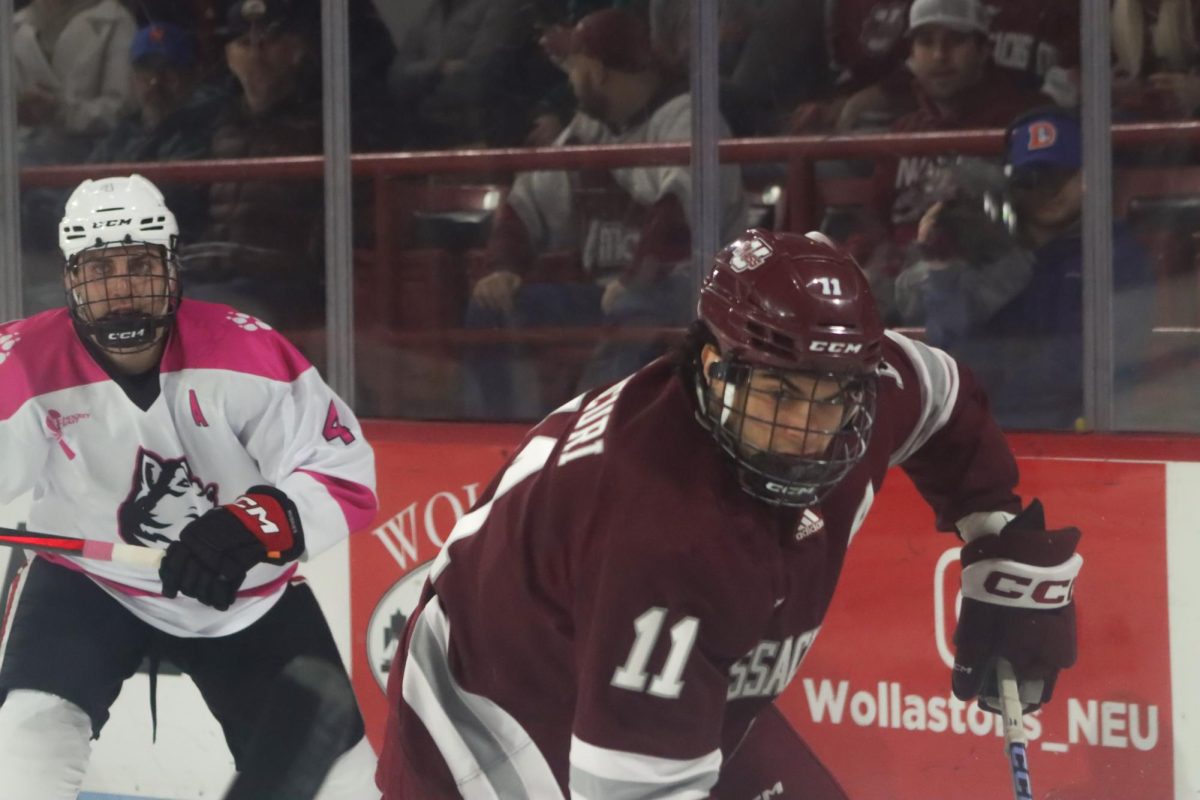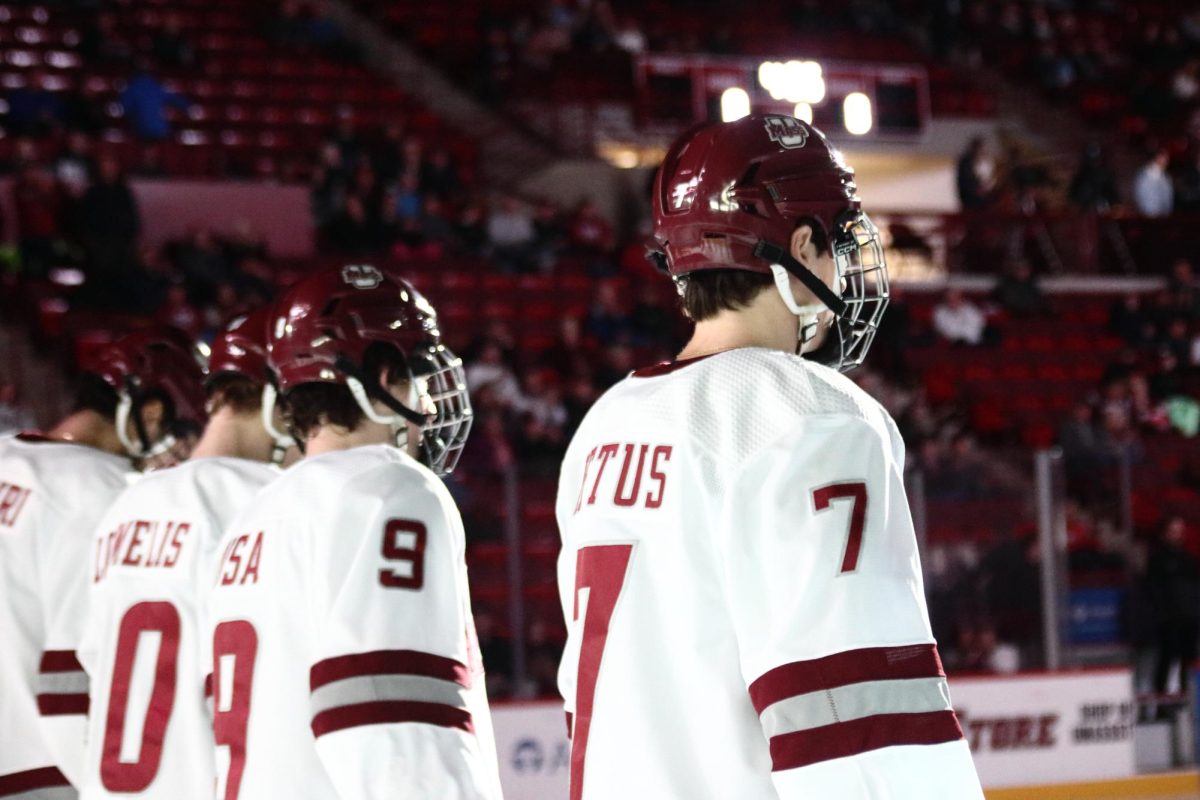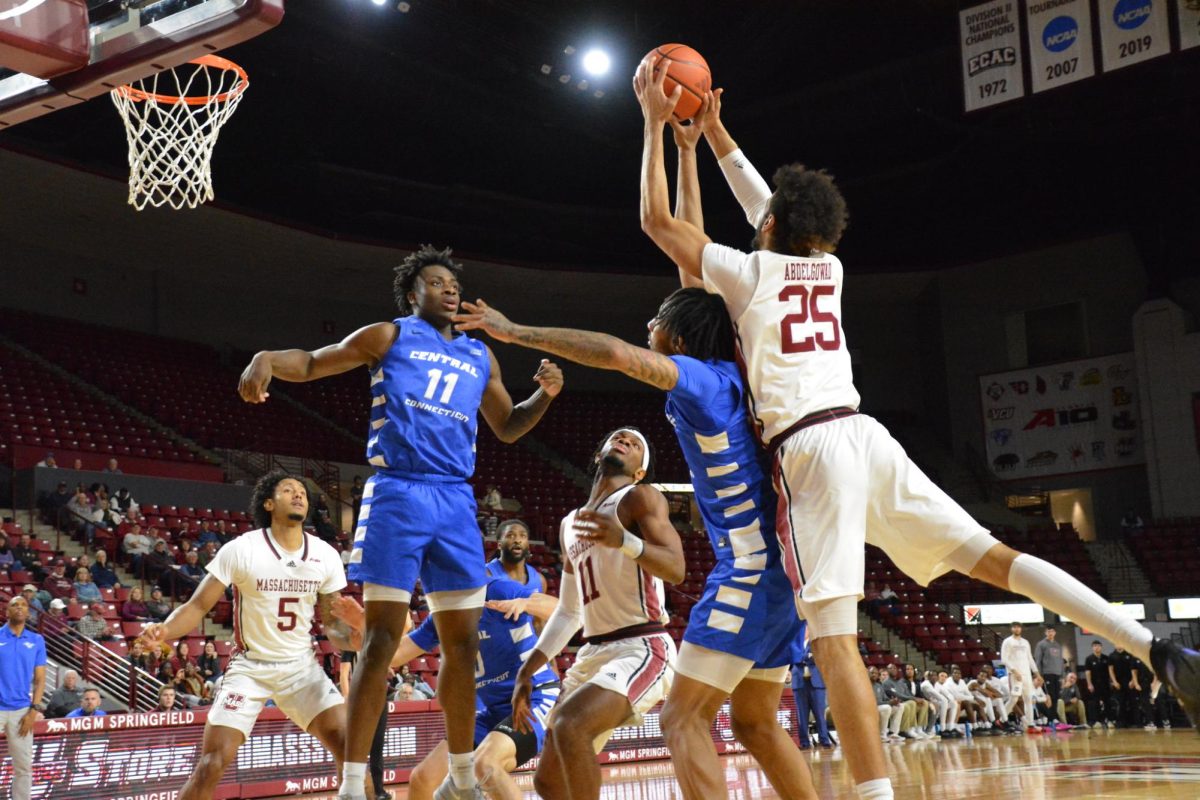
Since Ryan Bamford officially started his tenure as the University of Massachusetts’ new athletic director April 27, his travel schedule hasn’t allowed him to stay put in his spacious Mullins Center office for long.
This constant movement is not uncommon among new athletic directors looking to familiarize themselves with their respective campuses and interact with the local communities. But Bamford, who became the seventh permanent athletic director in UMass history, has taken this outreach to a wider level.
Over his first four months on the job, Bamford estimates he’s put more than 6,500 miles on his car traveling back-and-forth across Massachusetts and the New England region to “plant UMass’ flag” around the Commonwealth.
“I’ve just put my head down and tried to focus on getting to know people, understanding our culture internally and just immersing myself in all UMass has to offer,” Bamford said.
Whether it’s been attending donor meetings, alumni functions or participating in charity golf tournaments around Massachusetts, Bamford said his trips’ purpose revolves around the same central idea: visibility.
“Planting the flag” has become a common moniker around the department according to Bamford, and is something that represents his initiative to connect with as many students, fans, alumni and other constituencies around the region.
“I’m a big believer in being as transparent as we can be in what we do and our approach,” Bamford said. “I feel like people will invest in your program if they know that you’re transparent and that you’re trying to do better.”
Increasing exposure
Bamford acknowledged that as students flood back onto campus and the fall sports season enters full swing, the frequency of his trips will inevitably slow down from its current weekly basis. However, he said making an effort to maintain an active traveling schedule is imperative.
“In the interview process, I told the committee that if I’m not putting 20,000 miles on my car in year one then I’m not doing my job of getting out and planting our flag,” Bamford said. “I believe strongly in that.”
Before arriving at UMass, Bamford spent the previous four years at Georgia Tech, including the last two as senior associate athletic director.
He explained how his time at the Atlantic Coast Conference school provided him with invaluable experiences in marketing “a true (Football Bowl Subdivision) program.” However, he noted that the difference in location calls for a slightly modified strategy.
“Coming from Georgia Tech, we were in the Metropolitan area, we were in Atlanta. So we were speaking to our constituency right there on our own soil within a 30-mile radius,” Bamford said. “We can’t activate UMass athletics from Amherst, that’s not going to be successful.”
Instead, Bamford reiterated the importance of branding at a statewide level, especially in the eastern Massachusetts area where Bamford said a large part of the University’s interest base presides.
“We need to activate where our base is – where our students come from, where they go back to when they graduate, which in large part is inside that (interstate) 495 and (route) 128 corridor.”
New senior associate athletic director for external relations Tom McElroy, Bamford’s first hire this summer, shares in this belief in increasing UMass’ exposure. He also proudly accepts the credit for coining the phrase “planting the flag.”
“When we go to Boston, it shouldn’t be because we’re in the Hockey East and playing Northeastern and BU or BC. Maybe it’s a major game in the (TD) Garden or a top game in Springfield,” McElroy said. “If you look at our independent schedule coming up, we’re playing national brands now. So when they come to Boston, that name as much as our name will get the fans reading the sports section and say, ‘Hey I want to go see that game.’”
McElroy added: “That’s how a flagship behaves. We’re a university from the Berkshires to Brockton, from Cape Cod to Lenox. It’s that idea that when (alumni) leave here and graduate, they don’t just migrate east of Worcester and never get back here.”
Staff changes
McElroy joined Bamford’s staff on May 26 in a role that overlooks public relations, communications, ticket sales, marketing, television, creative services and other external services. But his connection to Bamford dates past their May staff opening discussions.
McElroy was senior vice president of the sports division for Leffler Agency while Bamford worked at Georgia Tech, one of the agency’s clients. In this time, although the two did not directly work together, McElroy said he came to know and respect Bamford’s leadership style based on his interactions with the school’s external marketing staff that reported to Bamford.
The two reconnected shortly before Mother’s Day weekend when Bamford called and notified McElroy that he’d like to offer him a position.
“I remember saying to him when we were sitting at a game at Georgia Tech one time, I said sometime in my life I wouldn’t mind being on a staff with a new AD where I don’t need a corner office anymore and I don’t need to have my name on the door,” McElroy said. “So as he was thinking about what he wanted to do here, he called and said to come see him.”

McElroy was just the first of many position hires made by Bamford over his first four months at UMass. During this time, Bamford has appointed five new administrators, including two for newly-created positions.
Bamford said McElroy’s experience as deputy director of athletics at Connecticut, where he oversaw the Huskies’ transition to Division I-A football, was a major selling point and will undoubtedly help UMass’ football program, which similarly achieved FBS classification in 2012.
“Inside of five years, (UConn) was playing in the Fiesta Bowl. He’s seen it work,” Bamford said. “He has expertise in media, television agreements and licensing and all those external pieces.
“I thought he was a really good person to complement the strengths that I have.”
McElroy’s internal counterpart, Darrice Griffin was named to the newly-created position of senior associate AD for internal operations and senior woman administrator in early June.
Molly O’Mara, a 2004 Isenberg School of Management graduate with a decade of experience working with “Power 5” football schools Arkansas, Texas Tech and Arizona, was later named associate AD for communications and public relations and became the primary media relations contact for the football program.
With these three hires, in addition to others, Bamford said that one of the central goals has been to build a staff with rich experience that allows the University to “continue to help move the needle on things that (it) does athletically.”
In particular, he noted the importance of adding experienced pieces in managing an FBS football program, in terms of McElroy and O’Mara, to complement his own background gained from Georgia Tech.
“For bringing someone else who has marketed and had done public relations for a major I-A program, that to me is … if we’re going to act like that, we’re going to need someone to come in and do some of that,” Bamford said.
McElroy added that Bamford’s hiring decisions have shed light on the positive direction Bamford is working toward.
“Mark Twain had a great quote that a smart man always hires smarter people,” McElroy said. “I’ve actually heard Ryan paraphrase that.”
He added: “It really starts with the resources in place and the leadership. It’s in place for us to be successful.”
Social on social media
While Bamford continues to remain visible with his active travel schedule, he has also made a tremendous effort to stay transparent via social media.
With a daily influx of questions and comments sent his way on Twitter from students, fans and alumni, Bamford often takes time to answer scheduling questions, provide facility renovation updates and other common concerns. Perhaps the prime example of his online interactions came in a mid-June question-and-answer session in a live 45-minute online chat.
“When we announce things and when I engage with folks on Twitter or any of our social media channels, it’s really to spread our message and plant our flag socially to people,” Bamford said. “It’s to show them that I’m just as passionate about UMass athletics as (they) are and (they’re) just as passionate as I am and our coaches and student-athletes are.”
Bamford added that this back-and-forth communication with fans has helped him further immerse himself in the culture around UMass.
“I want to hear all the ways we can be better and I’m open to listening. I want to engage because I’m still a sponge and I’m still learning a lot about our culture and the things we’re trying to do,” Bamford said. “I want people to buy in, and the way to do that is by being transparent and having dialogue.”
He added: “It’s a way for me to stay connected. I don’t ever want to take my finger off the pulse of UMass nation and some of the folks who are heavily invested in our programs.”
Like in the case of his statewide trips, Bamford said there’s no doubt his social media activity will continue in his first full semester as athletic director. He added he is excited to interact with students both online and at campus events.
Increasing student involvement – and attendance – is something Bamford said is crucial in developing winning programs. Pointing toward arenas like Duke’s Cameron Indoor Arena and places in UMass’ own conferences, such as Rhode Island and Richmond in Atlantic 10 basketball, Bamford said active student engagement and excitement is the reason the teams win the majority of their home games.
Bamford said building similar atmospheres at the Mullins Center, McGuirk Stadium and other on-campus athletic venues at UMass is possible and will lead to more consistent success.
“Our home environment, especially in football, hockey and basketball, protecting our home field, our home ice or home court is really important to us,” Bamford said. “The best way to do that is through really good student engagement. If we have great environment in those three sports, it’s going to allow us to be successful.”
He added: “I want the students to be part of what we do and that’s going to be one of the things we really focus on. If we’re going to have success, it needs to happen with the population, 20,000 of them, that lives right here.”
Anthony Chiusano can be reached at [email protected] and followed on Twitter @a_chiusano24.


















